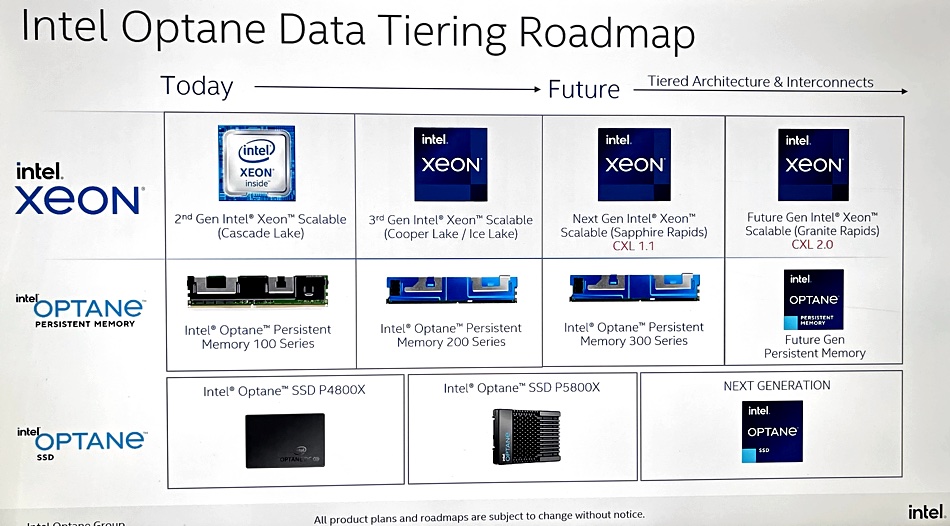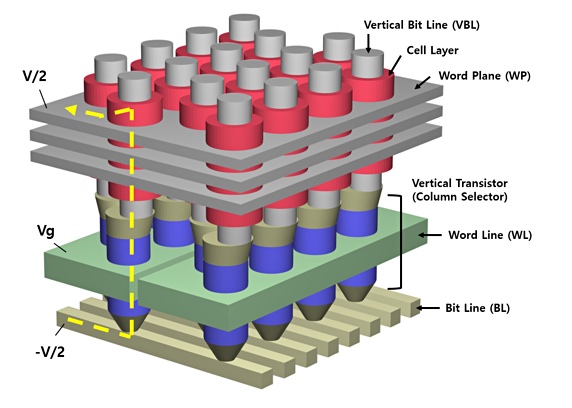Intel has no 3D XPoint manufacturing capability, no plans to start XPoint manufacturing, and made no public commitment to develop third or fourth-generation XPoint media. SK hynix could possibly step into the breach.
That’s the picture that emerged after talking to a semiconductor industry source with knowledge of the Optane XPoint situation. Optane Persistent Memory and SSD products are built using 3D XPoint chips. The Micron XPoint fab at Lehi built way more XPoint chips than Intel needed and Intel now has a large inventory of chips waiting to be used. Once Micron closed Lehi down, Intel’s own Rio Rancho site – which was used for XPoint development – was repurposed for backend processes.
We asked Intel to confirm that it has no 3D XPoint manufacturing facility or plans to build one, and no plans to develop third-generation 3D XPoint media. The detailed questions we asked were these:
- Can you confirm please that Intel has no 3D XPoint manufacturing capability following the closure of Micron’s Lehi plant?
- Could you confirm please that there is no third-generation 3D XPoint development plan or manufacturing plan?
- Could you also confirm please that there is no fourth-generation 3D XPoint development plan or manufacturing plan?
- Is it true that the PMem 200 Series products use a class of 3D XPoint chips between gen 1 (2-deck) and gen 2 (4-deck)?
- Is it true that generation 4 Optane, that could have CXL 2.0 support, may not use 3D XPoint media and use a different persistent memory technology instead?
- Is it Intel’s intention to use up the current 3D XPoint inventory and then move to a future and different persistent memory technology?
David Tuhy, VP of the Intel Data Center & AI group and GM of Intel’s Optane Solutions and Software Division, gave us a general and not specific response: “There is no change relative to our Intel Optane business that we have to announce at this time. We are continuing see the cost savings of memory tiering and the capacity value of Optane attached to new customers and grow adoption for cloud and enterprise usage. Please see the Meta disclosure on ‘Intel Optane Memory Requirements of Meta AI Workloads‘.
“As we have shared, we plan to release our third-generation Persistent Memory module this year, and we are working on our fourth-generation and first CXL version.”
That Meta (Facebook’s parent) disclosure was made at a Tech Field Day 25 presentation by Meta’s Ehsan Ardestani, Chris Petersen and Manoj Wadekar on April 18. The three said that Meta gained application performance and cost efficiencies by using Optane devices.
It’s estimated that Intel has about two years’ worth of XPoint chip inventory, and that means gen 2 four-deck 3D XPoint, as used in the Optane PMem 200 series products. The company has publicized a roadmap with third- and fourth-generation Optane products, both Persistent Memory (PMem) and SSD.

There is now a separation between Optane media generations and 3D XPoint generations. We already know that Intel will use existing gen 2 3D XPoint media in its third-generation Optane SSDs and Persistent Memory products. But what will it use on its fourth-generation Optane products? Will the gen 2 XPoint chip inventory still exist at that point? Even if it does, will that gen 2 XPoint media be fast enough or dense enough to meet what the roadmap calls “Future Gen Persistent Memory” and “Next Generation” Optane SSD?
Tuhy did not answer these questions.
With no faster or denser 3D XPoint chips being developed, this could mean Intel will need a new storage-class memory for its fourth-generation Optane products. It could use Kioxia FL6 storage-class Memory NAND. Another possibility is SK hynix’s 3DVXP, or 3D vertical cross point memory.

SK kynix has a new memory (NM) technology research focus and expects this to bridge the gaps between DRAM and NAND in terms of performance, latency, and cost – the original Optane role. The NM R&D focus is using phase-changing materials to make 3D XPoint memory. SK hynix believes that its 3DVXP technology can potentially extend the roadmap of storage-class memory further than the current scalability of the 3D XPoint technology.
SK kynix researcher Sijung Yoo will present a 3DVXP paper at the 2022 IEEE International Memory Workshop in Dresden, May 15–18. The paper, entitled “Structural and Device Considerations for Vertical Cross Point Memory with Single-stack memory toward CXL memory beyond 1x nm 3DXP,” will propose 3DVXP using a “poly-Si vertical transistor” as the next-generation, byte-addressable, storage-class memory technology.
Intel did not sell its Optane/3D Point operation to SK hynix when the latter bought Intel’s SSD business. And Pat Gelsinger, Intel’s CEO, told Stratechery’s Ben Thompson: “I never want to be in memory, you see I’m doing everything I can to exit our memory businesses in that regard.”
It’s tempting to connect up these various dots and see SK hynix fulfilling Intel’s storage-class memory needs in the future.






